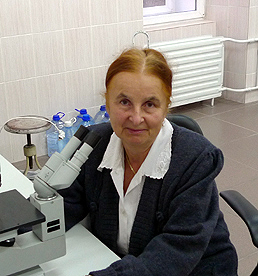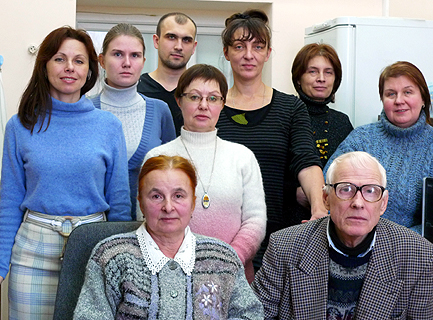| Group of Genetic Mechanisms of Cell Differentiation and Malignization |
|
Head of the Group Tatiana M. GRINCHUKPh.D., Leading ScientistPhone: +7 (812) 2972313
|

|

|
Scientific Staff:
Kozhucharova I. V.
Anisimov S. V.
Artsybasheva I. V.
Alekseenko L. L.
Kovaleva Z. V.
Pugovkina N. A.
Zemelko V. I.
Domnina A. P.
|
|
During the long time the research team has examined molecular and genetic mechanisms of adaptation, immortalization, spontaneous and induced transformation of mammalian cells on primary and permanent human and rodent cell lines. In recent years the team interest has been focused on establishment of human embryonic and mesenchymal stem cells, their characterization and differentiation into various lineages. Current methods of cell and molecular biology are used for the research. A number of permanent cell lines with various resistances to DNA damage agents (adriamycin etoposide, ethidium bromide) were established. These cell lines are characterized by genome instability: aneu- and polyploidy, structural chromosomal rearrangements and appearance of amplification morphological markers. It has been shown that ectopic overexpression of bcl-2 or survivin in these cell lines accelerates the process of karyotype destabilization. Karyotypes of cell lines used in the study are presented in "Atlas of Chromosomes of Human and Animal Cell Lines", Moscow, 2002. Together with Biological Research Institute of St. Petersburg State University we investigated antitumor activity of peptides, alloferons 1 and 2, isolated from larval hemolymph of Calliphora vicina (Diptera). It was found that alloferons possess radio protection activity and increase immune response against weak antigens. The results of clinical trials showed that these peptides suppress the development of diseases caused by herpes and papilloma viruses. These data may be used for the development of new approaches to antitumor therapy. Since 2002 the interest of the Research Group was focused on embryonic and adult stem cells. The main task was to obtain human embryonic stem cells from intracellular mass of pre-implantation blastocysts, to maintain stem cells in vitro in the undifferentiated state and to characterize their pluripotency. A number human embryonic stem cell lines were obtained and characterized. It has been shown that under certain conditions these cells are able to differentiated into dopaminergic neurons. The study showed that these cells are of potential value as a source of dopaminergic neurons for cell therapy of Parkinson's disease. Much attention is paid to genetic stability of human and mouse embryonic stem cells. It has been found that long-term cultivation of mouse and human embryonic stem cells may be accompanied by progressive instability of their karyotype. A number of mesenchymal stem cell lines of endometrium origin has been obtained, characterized and probed to transdifferentiation. Selected publications (2000-2010): Melixetian M. B., Beryozkina E.V., Pavlenko M.A., Grinchuk T.M. 2000. Altered expression of DNA-topoisomerase II alpha is associated with increased rate of spontaneous polyploidization in etoposide resistant K562 cells. Leuk. Res., 24 : 831-837. Grinchuk T.M., Pavlenko M.A., Pugovkina N.A., Alekseenko L.L., Kovaleva ZV., Melixetian M.B. 2000. Effect of ectopic overexpression of the antiapoptotic gene bcl-2 on the level and character of caryotypic instability in golden hamster cell line CHL V-79 RJK. Tsitologiya, 42: 1004-1014. Chernysh S., Kim S.J., Bekker G., Pleskach V.A. et al. 2002. Antiviral and antitumor peptides from insects. PNAS USA., 99 : 12628-12632. Melixetian M.B., Pavlenko M.A., Beryozkina E.V., Kovaleva Z.V., Sorokina E.A., Lipskaya L.A., Ignatova T.N., Grinchuk T.M. 2003. Mouse myeloma cell line Sp2/0 multidrug-resistant variant as parental cell line for hybridomas construction. Hybridoma and Hybridomics, 22 : 321-327. Grinchuk T.M., Pugovkina N.A., Tarunina M.V., Sorokina E.A., Rozanov Yu.M., Ignatova T.N. 2004. Immortalized cell lines obtained from transgene mouse embryos are characterized by progressing destabilization of caryotype structure. Tsitologiya, 46: 62-68. Nikolskii N.N., Gabai I.F., Somova N.V. Human Embryonic Stem Cells: Problems and Perspectives. 2007. Cell and Tissue Biology, 1: 375-383. Grinchuk T.M., Ivantsov K.M., Alekseenko L.L., Kozhukharova I.V., Zaichik A.M., Petrov N.S., Mikhailov V.M., Popov V.B. 2009. Characterizations of the Murine Mesenchymal Cell Line Expressing GFP. Cell and Tissue Biology, 3, 1:29-34. Kozhukharova I.V., Fridlyanskaya I.I., Kovaleva Z.V., Pugovkina N.A., Alekseenko L.L., Zenin V.V., Ivantsov K.M., Leont'eva O.K., Grinchuk T.M., Nikolskii N.N. 2009. Novel Human Embryonic Stem Ņell Lines C612 and C910. Cell and Tissue Biology, 3:519-526. Kozhucharova I. V, Fridlyanskaya I. I., Zemelko V.I., Kovaleva Z. V.,. Pugovkina N. A, Alekseenko L. L., Charchenko M.V., Shatrova A.N., Aksenov N.D., Grinchuk T. M., Anisimov S.V., Nikolsky N. 2010. Generation of dopamine neurons from human embryonic stem cells in vitro. Tsitologiya, 52: 875-882. |
| Department of the Intracellular Signalling and Transport | Structure | Home | |